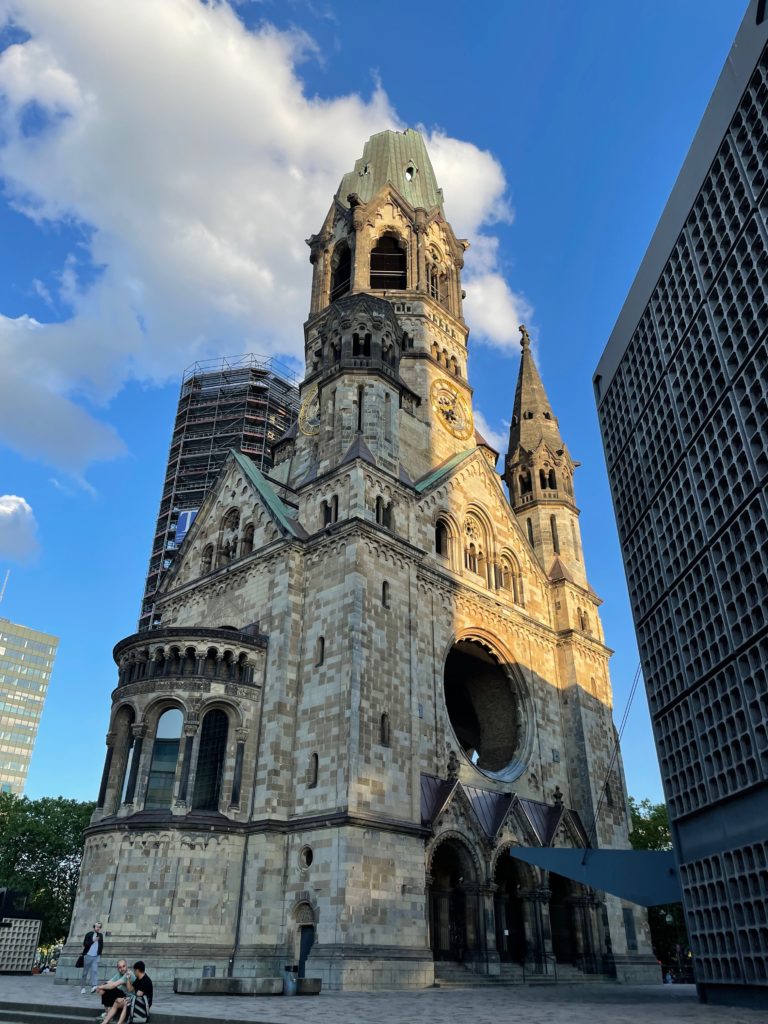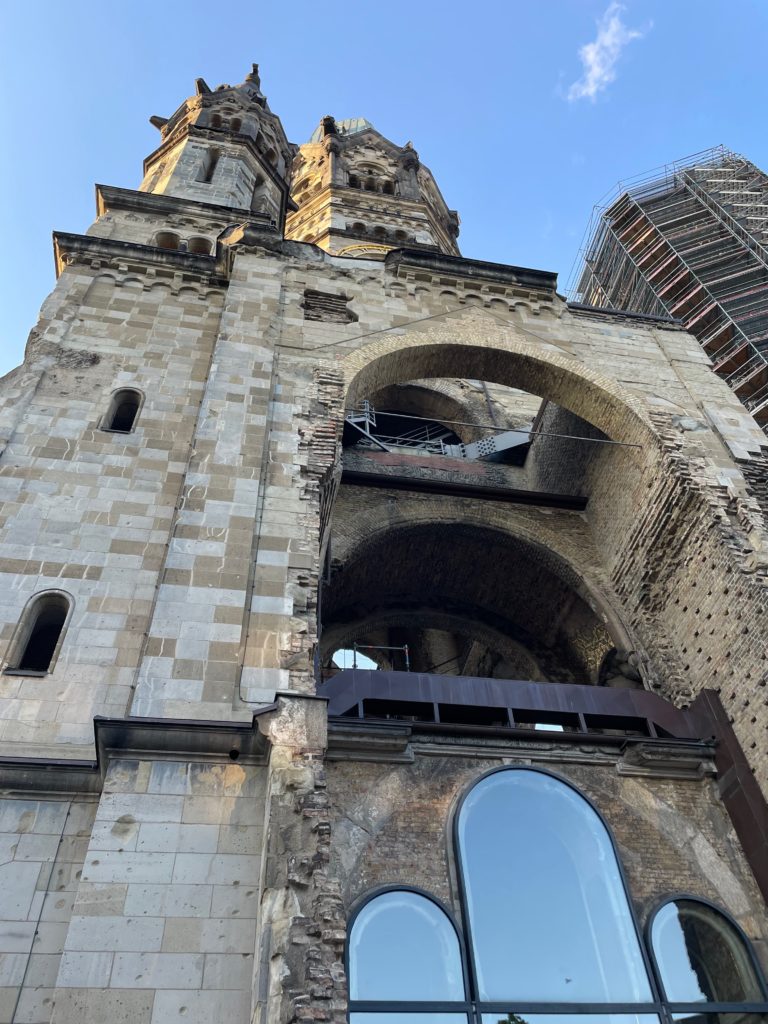Visiting Berlin, near the Tiergarten and the Zoo Berlin, there’s a somewhat surprising building that looms over Kurfürstendamm. A clock tower, copper-roofed and crumbling, stands over the plaza and the surrounding area. It’s surprising because it looks decayed, destroyed: the rose window is empty, the trefoiled arches are knocked out, and the topmost spire is caved in. The local name for it is der hohle zahn: “the hollow tooth”.
But this tower isn’t abandoned; it’s still maintained regularly, preserved in destruction. That’s because what was built as the Kaiser Wilhelm Memorial Church in the 1890s (German: Kaiser-Wilhelm-Gedächtniskirche) is now used as another memorial, dedicated not to the Kaiser, but to peace.

Kaiser Wilhelm Memorial Church, seen from Budapester Straße.
The church is German Evangelical, initiated by Kaiser Wilhelm II and dedicated in 1895 in honor of the aforementioned Kaiser’s grandfather, Wilhelm I. What we see today is merely the spire; the original Neo-Romanesque church was big enough to seat over 2,000 people and stretched out to cover most of Breitscheidplatz. In its heyday, the church was a symbol of the Brandenburg area, but in a very different way from today.
But in 1943, the church was badly damaged by an Allied air raid; only the spire, altar, baptistery, and parts of the entrance hall remained. After the war, the decision was made to tear the old spire down, but public outcry ensued. The citizens of Berlin had decided that this damaged, crumbling tower had in it the spirit of the city. So today, the tower still stands, saved in the moment of destruction like a fly in amber.

Kaiser Wilhelm Memorial Church, seen from Breitscheidplatz.
Looking at the tower, one can’t help but note just how badly damaged the spire really is. Many of the bricks and columns are charred and blackened by fire; entire windows and arches are smashed out clumsily; the roof is opened directly to the sky through an impromptu oculus. Walking around, the damage becomes much more apparent; decorations become ghosts of pale stone outlines, individual bricks protrude almost violently, and the bricks are peppered with mortar rounds.
And consider the psychological impact of the monument too: this is a symbol of the violent bombing of the city it sits in. Just a few months after the raid that destroyed most of the Kaiser Wilhelm Memorial Church, the Battle of Berlin began. The raid on November 22 alone killed 2,000 Berliners. And this is a war that Berlin started in the first place!
At first glance, one wonders why this memorial even exists. The sheer amount of pain the building conjures, even after over 70 years after the end of the war, is hard to imagine. And this, of course, ties into the resentment that some Germans feel about their nation. It seems as if Germany is stuck in a never-ending, demeaning cycle of apologizing about its role decades ago.
But the Kaiser Wilhelm Memorial Church stands against this narrative of a subservient and beleaguered Germany, weakened by apologies. In my opinion, the church tells a different story entirely, one of the pain felt by ordinary German citizens. It was the people who paid the price for Hitler’s folly; it was the people who were left homeless and grieving. That’s not to say that the memorial takes away the blame that must be given to the people of 1930s Germany; Hitler, after all, was cheered by adoring crowds. Rather, the memorial speaks of the terrible human price of war, of the pain that the people go through during conflict; so really, the Kaiser Wilhelm Memorial Church stands as a memorial to all mankind. The hollowed spire stands as a quiet reminder of that old adage: war doesn’t determine who is right, only who is left.
In a day and age where civilians are killed by wars all around the globe, it’s easy to take this as an unfortunate constant at best, or as a necessary action at worst. But the heart of Berlin reminds us otherwise: the spire stands against the terrible cost of war, and for the peace that mankind needs urgently.
The rededication plaque in front of the church says it all. It reads:
THE FORMER ENTRANCE HALL
OF THE OLD
KAISER-WILHELM-MEMORIAL-CHURCH
WAS ON 7 JANUARY 1987
REOPENED AS A MEMORIAL HALL
IT IS A PLACE OF ADMONITION
AGAINST WAR AND DESTRUCTION
AND A CALL TO RECONCILIATION
IN JESUS CHRIST